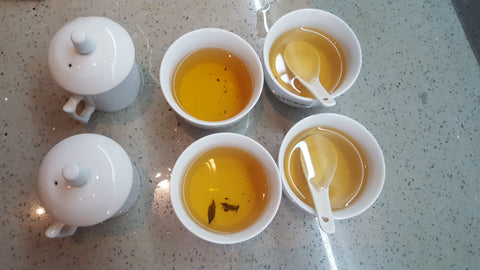A Beginner's Guide to Tasting Tea
Here is my 5 step guide to tasting tea, which I would recommend to anyone looking to develop their taste palate. Remember: Tea tasting is highly individual, so just have fun and trust your taste buds!
1. Examine the Dry Leaf

The first step we always take, even before brewing tea, is to study the dry tea leaves. This tells us about the plucking and processing of the tea, and can give us an early indication of the quality level.
You'll want to take note of the size, consistency, color, shape, and texture of the leaves. In general, high quality teas are made up of whole leaves that are consistent in size and shape, as opposed to crushed or broken pieces. If you see any tips or buds in your tea, you may be drinking a more premium tea.
Different tea categories have different quality markers. For example, white tea buds should be coated in a layer of fine, white hairs (like in the photo above). Not to worry - This will become easier to identify with time and experience.
TIP: When I first started tasting teas, I would draw the dry leaves as it helped me inspect the leaves on a closer level, and remember it in the future.
2. Smell the Dry Leaf

Believe it or not, smell is just as important as taste in the tea world.
Bring the dry leaves up to your nose and take a deep breath. What aromas are you getting? Grassy, floral, nutty, fruity, woodsy, earthy? Write these down.
TIP: If the dry leaves aren't very fragrant, that's not necessarily a bad sign. Rinse your vessel with hot water, add the tea leaves into the warm vessel, shake lightly and then smell the leaves again. You'll immediately notice a much more vibrant aroma. By bringing the leaves into contact with slight moisture and heat, the fragrance really comes out!
3. Brew the Tea
Now it's time to brew the tea. It's up to you whether you want to brew it Western style (longer infusions in a large mug or teapot) or Gongfu style (flash brews in a small gaiwan or teapot).

Once the tea is brewed, take note of the color of the tea liquid (referred to as liquor in the industry). This can be anything on the spectrum of yellows and greens to reds and browns. Whatever the color, the infusion should be clear (not cloudy). Lighter colored teas tend to be lighter in taste, while darker colored teas tend to be stronger. However, this is not always the case.
4. Smell the Wet Leaf

Now that the leaves are wet, there should be an obvious fragrance. Bring the leaves up close to your nose once again and inhale deeply. Take note of the aromas you are getting, and compare them with your notes from earlier. If you are still not sensing much aroma, this could be a sign that your tea leaves are old or haven't been stored properly and this would be confirmed by a flat taste.
TIP: If you are a lover of aromas, you can also sniff your empty teacup after drinking the tea. This is common practice in Taiwan, where they have a Wen Xiang Bei, literally meaning smelling cup, entirely dedicated to this purpose.
5. Taste
Finally! You may taste the tea.
Similar to wine tasting, professional tea tasters will slurp and swish their teas. This is done to aerate the tea and enhance the flavors, as well as maximize exposure to taste buds. (In Darjeeling, I've even seen a designated bucket for tea tasters to spit their tea into after slurping and swishing!)

Hold the cup of tea to your lips and take a big slurp. Don't be shy - the louder the better. Then swish it around your mouth, making sure it reaches all areas, including your tongue, roof of your mouth etc. Finally, swallow the tea while exhaling through your nose.
This way of tasting may feel funny at first, but it really does enhance the flavors! Of course you don't need to do this for every single sip - that would be obnoxious - just when you are initially evaluating.
Flavor
As you sip on the tea, think of what flavors you detect. Flavor notes can be broad or highly specific. Some broad flavors include: Fruity, floral, sweet, nutty, vegetal, earthy, savory, spicy, and smoky. Within each of these categories, you can get more specific. For example, instead of fruity, sweet, and floral you might describe a tea as having notes of peach, honey and rose.
As a beginner, however, I would recommend starting with the broad terms and once you feel more comfortable you can dive into specifics. Just do as best as you can - It's a personal experience and there is no real right or wrong so just have fun!
Mouthfeel
As implied by the name, mouthfeel is the way the tea feels in your mouth. It's about the texture. We usually describe tea as either light, medium or full bodied. You can also use more specific words like creamy and buttery, or smooth and crisp to describe the texture.
Aftertaste
The last factor to pay attention to is the aftertaste. In Chinese there's a tea term called Hui Gan, literally meaning returning sweet, to describe the pleasant aftertaste or lingering sweetness of a tea. It's an important quality differentiator.
Pay attention to how the tea makes your tongue and throat feel after some time - is it drying and astringent, or smooth and cooling? A good quality tea should have a long-lasting and pleasant aftertaste: Some tieguanyins and pu'ers can have an aftertaste that lasts for hours. On the contrary, a poor quality tea may have an initially pleasant flavor that drops immediately or leave an unpleasant aftertaste.
Other Indicators

An evaluation wouldn't be complete without testing the tea's re-brewing ability - that is, how many times a tea can be re-brewed before its flavors are lost. Depending on your style of brewing, you should be able to brew anywhere between three and a dozen times. If the tea falls flat after one brew, that's probably not a good sign.
Another thing you may wish to take note of is the effects of the tea on your body - Does it help you feel calm and relaxed? Has your mood improved? On the contrary, does it have any adverse effects on you? Do you feel jittery or agitated? This can also help you evaluate the tea in question, and give you a better idea of which teas suit you best.
Want to learn more?
If you'd like a tool to help you record your tea tastings and develop your palate, check out our Tea Tasting Journal!
If you'd like to learn more about tasting tea through a guided experience, consider our online course: Taste Tea like a Professional.
Final Thoughts

I hope this guide has helped you appreciate the teas you are drinking on a deeper level. By playing close attention to the appearance, aromas, flavors and effects of each tea, your tea tasting experience will be elevated and you will slowly develop your taste palate.
Remember: Examine, Smell, Brew, Smell, Taste (& Repeat). Happy tea tasting!
Discussion
How do you like to taste tea? Feel free to share or ask a question in the comments section below! ♥


1 comment
Your comprehensive guide to tea tasting is a treasure for beginners! The step-by-step approach, from examining dry leaves to evaluating aftertaste, offers a thorough understanding of the art of tea appreciation. Your tips on smelling dry and wet leaves and the unique tasting method make it an engaging and educational read. Cheers to exploring the world of tea with confidence!